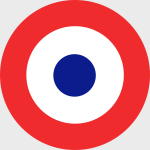Eaglemoss EM011 French Citroen Type 23 Light Truck - 49me Bataillon de Chars de Combat, Tannay, France, 1940 (1:43 Scale)
"A lost battle is a battle one thinks one has lost."
- Marshal Ferdinand Foch
 The U23, or Type 23, was a light (2-ton) truck introduced by Citron in 1936. Although the engine cowling and front body was looking similar with the Citron Traction Avant's, the U23 had a conventional rear-drive transmission.
The U23, or Type 23, was a light (2-ton) truck introduced by Citron in 1936. Although the engine cowling and front body was looking similar with the Citron Traction Avant's, the U23 had a conventional rear-drive transmission.
The production lasted for a very long time, from the late thirties to the early sixties. One major customer was the French military, who ordered large quantities of Type 23s after the declaration of World War II. At the time of the German invasion, more than 12,000 Type 23 had been delivered in less than ten months. About 6000 Citron U23 were pressed into German service after the French defeat of june 1940.
There has been two distinct body styles, since the U23 underwent a major restyling in the fifties. The Citron U23 was replaced by the Citron 350 to 850, also called Belphegor.
Pictured here is a 1:43 scale replica of a French Citroen Type 23 Light Truck that was attached to the 49me Bataillon de Chars de Combat, then deployed to Tannay, France, during June 1940.
Now in stock!
Dimensions:
Length: 4-1/2 inches
Width: 2 inches
Release Date: April 2014
Historical Account: "Classroom Lessons" - Neither the French nor the British anticipated such a rapid defeat in Poland, and the quick German victory, relying on a new form of mobile warfare, disturbed some generals in London and Paris. However, the Allies still expected they would be able to contain the enemy, anticipating a war reasonably like the First World War, so they believed that even without an Eastern Front the Germans could be defeated by blockade, as in the previous conflict. This feeling was more widely shared in London than in Paris, which had suffered more severely during the First World War in blood and material devastation.
The French leadership, in particular Edouard Daladier, Prime Minister of France since 1938, also respected the large gap between France's human and economic resources as compared to those of Germany.
The Supreme Commander of France's army, Maurice Gamelin, like the rest of the French government, was expecting a campaign from the Germans that in the strategic sense would mirror the First World War. The Von Schlieffen Plan, Gamelin believed, was to be repeated with a reasonably close degree of accuracy, and even though important parts of the French army in the 1930s had been designed to wage offensive warfare, it would be preferable to confront such a threat defensively, as the French military staff believed its country was not equipped militarily or economically to launch a decisive offensive initially. It would be better to wait until 1941 to fully exploit the combined allied economic superiority over Germany. To confront the expected German plan - which rested on a move into the Low Countries outflanking the fortified Maginot Line - Gamelin intended to send the best units of the French army along with the British Expeditionary Force north to halt the Germans in the area of the river Dyle east of Brussels until a decisive victory could be achieved with the support of the united British, Belgian, French and Dutch armies. The original German plan closely resembled Gamelin's expectations.
The crash in Belgium of a light plane carrying two German officers with a copy of the then-current invasion plan forced Hitler to scrap the plan and search for an original alternative. The final plan for Fall Gelb (Case Yellow) had been suggested by General Erich von Manstein, then serving as Chief of Staff to Gerd von Rundstedt, but had been initially rejected by the German General Staff. It proposed a deep penetration further south of the original route, which took advantage of the speed of the unified Panzer divisions to separate and encircle the opposing forces. It had the virtue of being unlikely (from a defensive point of view) as the Ardennes were heavily wooded and implausible as a route for a mechanized invasion. It had the considerable virtue of not having been intercepted by the Allies (for no copies were being carried about) and of being dramatic, which seems to have appealed to Hitler.
Manstein's aggressive plan was to break through the weak Allied center with overwhelming force, trap the forces to the north in a pocket, and drive on to Paris. The plan benefitted from an Allied response close to how they would have responded in the original case; namely, that a large part of French and British strength was drawn north to defend Belgium and Picardy. To help ensure this result, the German Army Group B was still expected to attack Belgium and the Netherlands in order to draw Allied forces eastward into the developing encirclement, as well as obtaining bases for a later attack on Britain.


